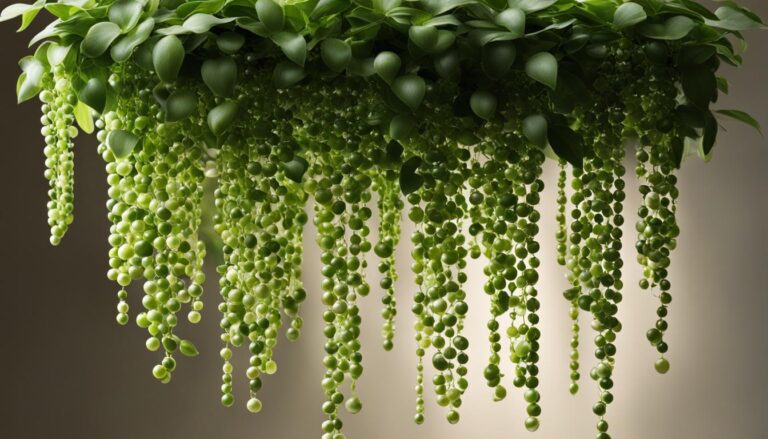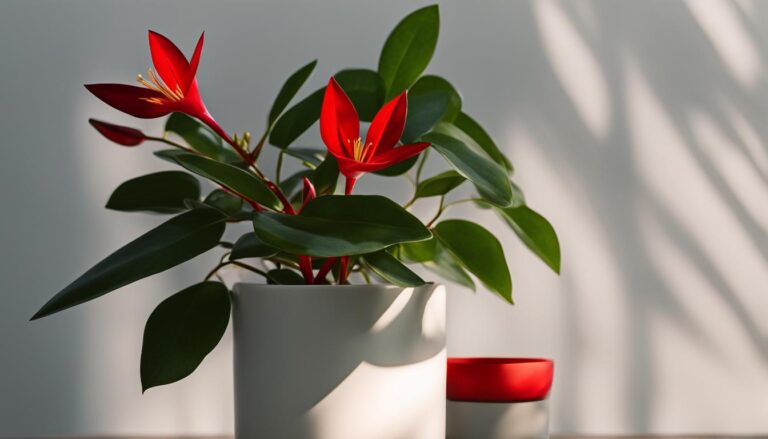
Welcome to the comprehensive guide on mastering Ficus Benjamina growth, also known as the Weeping Fig. As a highly cherished indoor plant, the Ficus Benjamina is known for its elegant appearance and adaptability.
In this guide, I will provide you with the essential knowledge and techniques to successfully nurture and grow this captivating Ficus tree.
Pruning plays a vital role in maintaining the health and shape of the Weeping Fig. I will discuss the importance of pruning, reasons for pruning, and the proper timing and techniques for effective pruning of Ficus Benjamina.
Also, I will cover other crucial aspects of Ficus Benjamina care, including lighting and watering requirements, tree shaping, and strategies for maintaining its overall health.
By the end of this guide, you will have the expertise to master the growth of your Weeping Fig, ensuring its beauty lasts for years to come. Let’s dive into the world of Ficus Benjamina care and discover the secrets behind this remarkable indoor plant.
Understanding the Weeping Fig: Appearance and Indoor Versatility
Ficus benjamina, commonly known as the Weeping Fig, is a visually stunning indoor plant that adds elegance to any indoor space.
This versatile tree is characterized by its slender, arching branches and glossy green leaves. The Weeping Fig can grow to an impressive height, making it a captivating focal point in your home or office.
One of the greatest advantages of the Weeping Fig is its ability to adapt to different light conditions. Whether your space receives bright indirect light or has moderate shade, this resilient plant can thrive in various lighting environments.
Its tolerance for different lighting makes it a popular choice for interior landscaping in both homes and commercial spaces.
There are several varieties of Ficus benjamina available, each offering unique characteristics and visual appeal. Some varieties have leaves with different shapes or colors, while others have different growth habits.
Choosing the perfect variety of Weeping Fig for your indoor space allows you to tailor the plant to your specific aesthetic preferences and design needs.
Varieties of Ficus Benjamina
| Variety | Characteristics |
|---|---|
| Benjamina | Classic Weeping Fig with glossy green leaves |
| Variegata | Leaves with cream-colored edges |
| Exotica | Variegated leaves with a mix of green, cream, and white |
| Golden King | Leaves with a mix of green and gold tones |
Understanding the appearance and indoor versatility of the Weeping Fig is essential in selecting the right variety for your space.
Whether you prefer the classic Benjamina variety or want to explore the unique characteristics of the Variegata, Exotica, or Golden King, there is a Ficus benjamina variety that will perfectly complement your indoor decor.
Nurturing the Weeping Fig: Sensitivity to Change and Key Care Factors
Caring for the Weeping Fig, or Ficus Benjamina, requires meticulous attention to its sensitivity to change. As an indoor tree, it can be particularly sensitive to environmental variations, such as relocation or alterations in light and temperature.
To ensure the well-being of your Weeping Fig, it is crucial to acclimate the plant gradually to any changes. This gradual transition helps prevent stress and leaf drop, allowing the tree to adapt and thrive in its new surroundings.
Pruning and Shaping for Optimal Growth
Pruning plays a vital role in the care of Ficus Benjamina. Regular pruning promotes new growth and helps maintain the desired shape of the tree. It is recommended to prune your Weeping Fig during the active growing season, typically in spring or summer.
Before pruning, make sure to sanitize your tools to prevent the spread of diseases. Focus on removing dead or diseased branches, as well as any crossing or crowded growth.
By enhancing sunlight penetration and air circulation through strategic pruning, you can ensure the overall health and vitality of your Weeping Fig.
Watering, Temperature, and Common Concerns
Proper watering is essential for the well-being of your Ficus Benjamina. It is advisable to allow the top few inches of soil to dry out between waterings.
Overwatering can lead to root rot, while underwatering can cause stress and leaf drop. Finding the right balance is key to maintaining a healthy moisture level for your Weeping Fig.
The Weeping Fig thrives in temperatures ranging from 65 to 75 degrees Fahrenheit (18 to 24 degrees Celsius). Avoid exposing your tree to sudden temperature fluctuations, as it can negatively impact its growth.
When caring for your Weeping Fig, it is essential to be aware of common diseases and pests that can affect its health. Keep an eye out for signs of fungal diseases, such as leaf spots or powdery mildew.
Insect pests like spider mites and mealybugs can also pose a threat to the Weeping Fig. Regularly inspect your tree for any signs of infestation and take appropriate measures to prevent the spread of pests.
| Care Aspect | Details |
|---|---|
| Light | Bright, indirect light. Avoid direct sunlight which can scorch leaves. |
| Water | Keep soil slightly moist. Water when the top inch of soil feels dry to the touch. |
| Humidity | Prefers high humidity. Mist regularly or use a pebble tray to increase moisture. |
| Temperature | Keep between 65-75°F (18-24°C). Avoid drafts and sudden temperature changes. |
| Soil | Well-draining potting mix. |
| Fertilization | Feed with a slow-release fertilizer during the growing season (spring and summer). |
| Pruning | Prune in late winter to maintain shape and promote growth. |
| Repotting | Repot every 2-3 years or when the plant becomes root-bound. |
| Toxicity | Toxic to pets and humans if ingested. Keep out of reach of children and animals. |
| Air Purification | Known to filter indoor air pollutants such as formaldehyde, xylene, and toluene. |
Propagation for Expanding Your Collection
If you’re interested in expanding your collection of Weeping Figs, propagation is a viable option. The most common propagation method for Ficus Benjamina is through stem cuttings.
Take a 6-inch cutting from a healthy branch, remove the lower leaves, and place it in a container filled with a well-draining potting mix. Keep the soil moist and provide the cutting with indirect light. With time, the cutting will develop roots and can be transplanted into its own pot.
Propagation allows you to share the beauty of the Weeping Fig with family and friends or create stunning arrangements throughout your home.
By understanding the sensitivity of the Weeping Fig to environmental changes and implementing key care factors such as pruning, watering, temperature regulation, and disease prevention, you can provide optimal care for your Ficus Benjamina.
With its elegance and adaptability, the Weeping Fig will reward you with years of lush green foliage and a captivating presence in your indoor space.
FAQ
How often should I prune my Ficus Benjamina?
Pruning should be done once a year, preferably in early spring. It is essential to remove dead or diseased branches to promote new growth and maintain the plant’s health.
What is the best time to prune my Weeping Fig?
Early spring is the ideal time to prune the Weeping Fig. This allows the plant to recover and grow during the active growing season.
How should I prune my Ficus Benjamina?
When pruning your Weeping Fig, use sharp, clean pruning shears to make clean cuts just above a leaf node or bud. This will encourage new growth and maintain the desired shape of the tree.
How much light does the Weeping Fig need?
The Weeping Fig thrives in bright indirect light but can also tolerate moderate shade. Place your plant near a window with filtered light or provide artificial lighting if needed.
How often should I water my Ficus Benjamina?
Water your Weeping Fig when the top inch of the soil feels dry. Avoid overwatering, as this can lead to root rot. It is better to underwater than to overwater this plant.
What temperature range is ideal for the Weeping Fig?
The Weeping Fig prefers temperatures between 60 and 75 degrees Fahrenheit (15 to 24 degrees Celsius). Avoid placing it near drafts or extreme temperature fluctuations.
What are common diseases and pests that affect Ficus Benjamina?
The Weeping Fig is susceptible to diseases such as leaf spot and root rot. Pests like scale insects and spider mites can also infest the plant. Regular inspection and proper care can help prevent and treat these issues.
How can I propagate my Ficus Benjamina?
Ficus Benjamina can be propagated through stem cuttings. Take a 6-inch cutting from a healthy stem, remove the lower leaves, and place it in a well-draining soil mix. Keep the soil moist and provide indirect light until roots develop.






